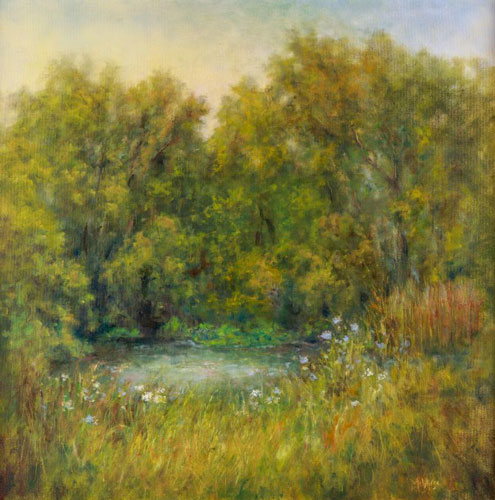Award-winning artist Mary Veiga is best known for her richly textured landscape paintings. In her distinctive style, she creates a “feeling” of light, the air, the atmosphere and grasses, tapping into all of the senses. Growing up on beautiful farmland, Mary naturally draws inspiration from nature and rural scenery. Spending time riding her horse through the striking abundance of Maryland’s landscape instilled in her a strong spiritual sense of attachment and belonging. This inspired her to share her experience through natural artistic expression. Her initial drawings and paintings focused on her horse and expanded to include a vibrant context of surrounding fields and trees. This work brought high recognition and awards from an early age. Her early influences, including Edward Hopper, Robert Henri, and William Merrit Chase, remain evident in her work to this day.
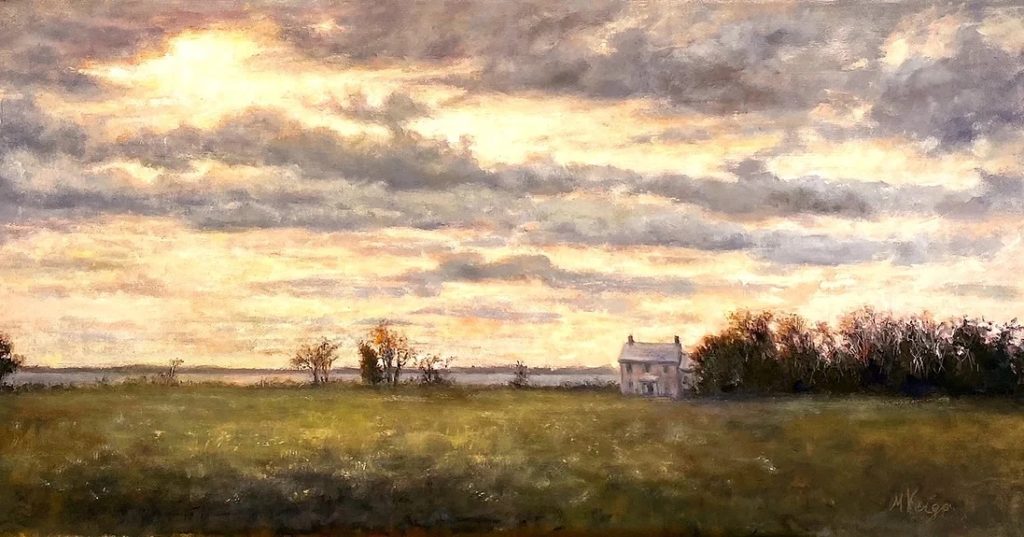
How did where you grow up influence your work today?
I grew up on a farm and surrounded by a lot of farmland and I just loved it and I loved being out there and all that it had to offer. From a very young age, I loved painting and drawing and especially my horses. They’re still a big part of my artwork. I like to paint very atmospheric, long views and really peaceful Scenes that are more inspirational.
I’m not sure many people who haven’t been to the area would necessarily know how beautiful it is; could you describe the landscape of Maryland and that area of the United States?
Well, it is beautiful and they call it “mini America” because we’ve got everything from the mountains all the way over to the ocean and the beach. In between that, we also have the Chesapeake Bay and a place in Tillman Island, which is a waterman’s village known for their oysters and crabs. It is just a beautiful, beautiful place. And that’s where I get a lot of subject matter. They have a lot of farmland out there, as well, and these breathtaking long views over the marshes. I really am in awe with the sunsets there. I think maybe because they’re across the bay, they’re very colorful. There’s always a lot of pink in them. I love all the color that light can bring, especially through the atmosphere. Tillman Island goes from north to south; it’s a straight peninsula, three miles by one mile, so we also get the best sunrises. It’s just a beautiful, really wonderful spot.

How did you begin to develop your sort of signature style of painting?
It’s been an evolution over time. However, I do notice continuous patterns and themes that I revisit. I really do love painting big skies and expansive views, and really setting a mood and trying to capture the feelings that I get when I see these scenes. Some of them aren’t necessarily from a real place, they’re from memory or some different images I’ve seen before. Putting it together, I try to use more of the feeling and the emotion as a focal point of what my paintings are.
What’s best is when it’s received by a viewer and they can feel the same wonderful feelings that you can’t necessarily put into words through the artwork.
I certainly do like to do a lot of rural scenes but sky seems to be something that I’m very much interested in. There’s so much you can do with the clouds and the movement and, to me, they’re very hopeful. They’re very calming, they’re very expansive and colorful.
Do you typically sit outside and paint the scene before you or do you have an image that’s sort of a reference point for you?
So, I do plein air. And I typically do that from the spring all the way through to the fall. Then I work in my studio, and they both are very helpful for each other.
With plein air studies, I learn an awful lot as I’m out there—you’re in the whole atmosphere and the environment and painting in the moment and just being on site. And then in my studio, I can really focus on working on a series of animals just from some images that I took from when I went down to Bath County for a plein air competition. Then later on, I’ve got more tools to use when I’m out there and more ideas of how to incorporate animals into my scenes.
You have to have some skills to bring from the studio to plein air and plein air is helpful to bring to the studio.
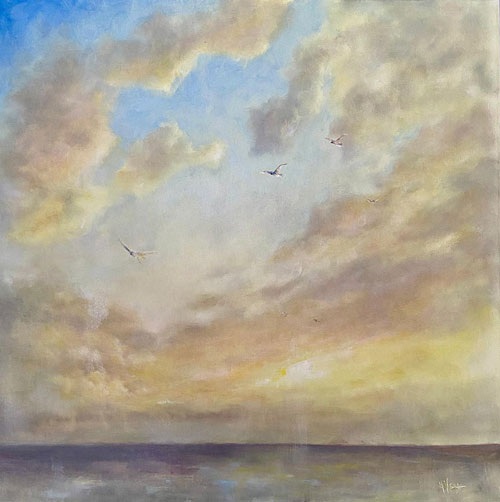
When you’re doing plein air, could you talk about the process for that?
A lot of times the goal is to finish it all in one sitting, unless I’m working on a larger piece. I want to have the bulk of it done in the first sitting, and the lighting might be completely different the next day. Everything might be different the next day. But I try to nail the initial lighting effects and color schemes and palette and everything, and design the first.
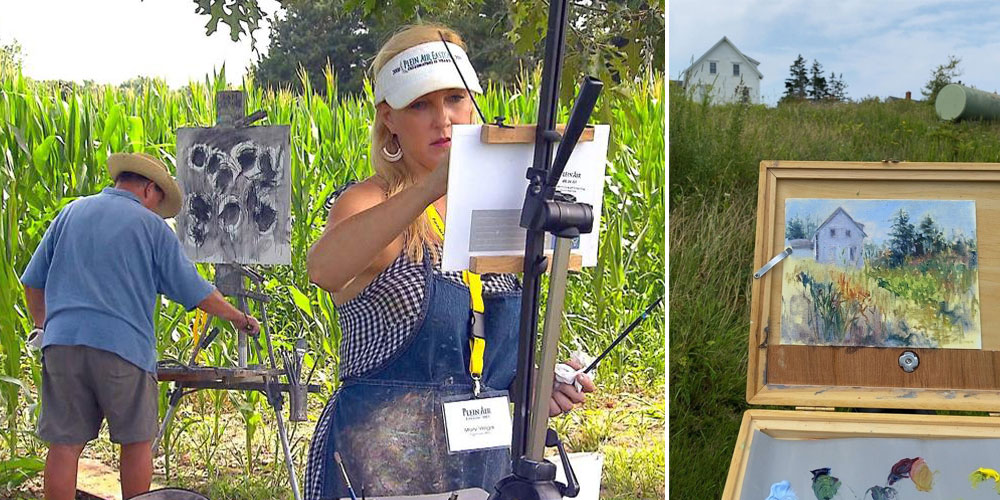
How did the experience of studying with artists continue to influence your work?
Well, I studied with David Buckley Good, who was a teacher at Schuller School, which is a classical realism school here in Baltimore. So really, really honing in on those fine arts, classical realism skills. Then I wanted to bring something a little bit more of an emotional expression to my art so I found a teacher named John Brandon Sills, whose work really resonated with me as highly emotional and special and atmospheric. Just his whole presence, that was what I was looking for and I went to study with him and it just completely made sense. His entire philosophy was exactly the right teacher at the right time for what I wanted to do.
It also happened to be right after my mother passed away and I was really looking for more of a connection and spiritual connection with nature. This was during that time and it just really brought everything together and made a big difference and took me, I feel, to a different level of expression in my artwork that was much more meaningful.
What was his philosophy that just resonated so much with you?
Well, he believes very strongly in the oneness of all of us, that we are all connected. He does that in his artwork through atmosphere and with very, very, very soft edges, or no edges a lot of times. It’s just beautifully done in a very impressionistic style. He really is masterful at very subtle color shifts that are so particular that there is no edge. It just shifts in such a subtle way, and I love using the whole spectrum of light in order to connect everything and to cast light on everything. The same sort of idea in my art, where we’re all connected and we’re all still together, even with our loved ones, through atmosphere and through nature.
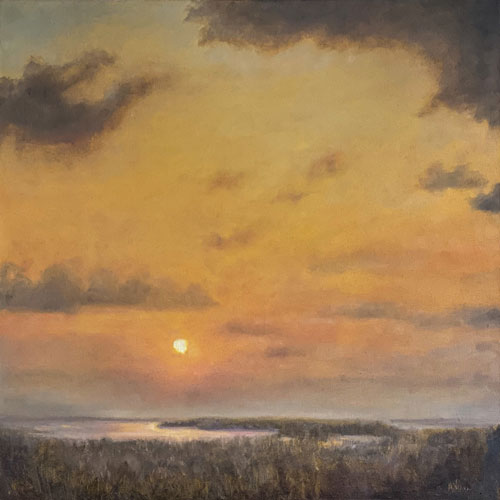
I saw that you teach as well. What is it like to take your work and then teach based off it?
Oh, it’s wonderful. I taught both youth classes as well as adult classes. It’s really a pleasure and a privilege to be able to work with young people and inspire them and have something to offer. I also teach adults, and I find it very rewarding as well, especially just to work with them on their own individual art journey and the projects that they want to work on, and helping them to achieve their goals in art. There’s so much that you learn from teaching, too. You start to realize what it is you’re doing and you have to really think about it and how to translate that. It just reconfirms a lot of things and habits.
